Northern convoys. Part I
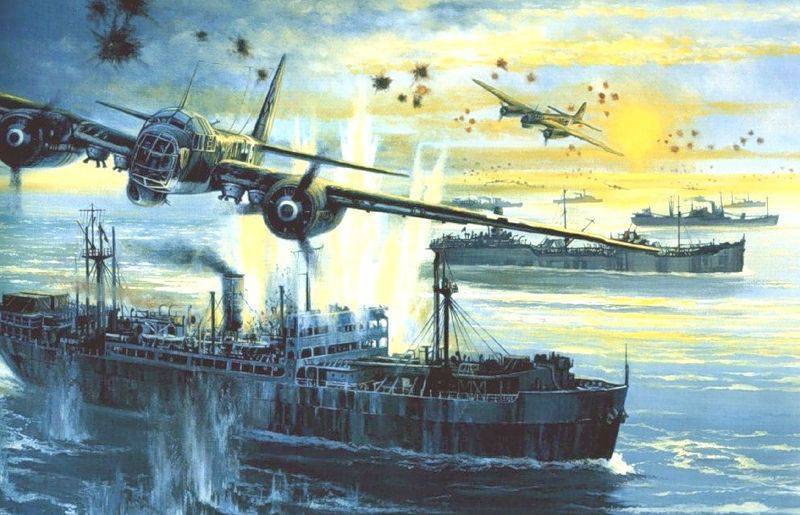
1 September 1939, Germany attacked Poland. Three days later, Great Britain and France declared war on the Germans. However, they did not undertake combat operations on land: a lull was lasting for nine months - a “strange war”. Only on the seas and oceans were battles associated with the breakthrough of the mutual blockade.
In April 1940, German troops launched a widespread offensive in the West, as a result of which most of continental Europe came under German control. Only island Britain desperately resisted the fascist raids aviationgetting ready to repel the landing.
16 July 1940, the year Hitler announced the preparation of Operation Sea Lion - the invasion of England. Until now, it is not known whether he planned it for real or whether it was an element of misinformation. But in any case, during this period the massive bombing of British cities and ports intensified. The sea blockade has become hardened: the German submarines blocked all the ways of supplying food and raw materials to the metropolis. The military and economic potential of Great Britain was severely damaged, the population was demoralized.
Suddenly, the situation has changed dramatically. 22 June 1941 g. Fascist troops crossed the border of the USSR. Fighting began on the eastern front.
In the book of V. Thompson, the personal bodyguard of English Prime Minister Winston Churchill, it is noted how this event was perceived in his immediate environment: extremely joyful for all of us. " E. Hughes writes directly that “Hitler’s decision to attack the USSR was for Churchill literally the gift of the gods. This was certainly the best news Churchill received over a long period of time. ” With the outbreak of hostilities in Germany on the eastern front of the UK received a reprieve. The main theater of the war became the Russian-German front.
On the day of the attack on our country, Winston Churchill delivered a speech on English radio. He made a decisive policy statement: "We will provide all the help we can to Russia and the Russian people." However, another part of his speech made one doubt the sincerity of these statements. The English PM recalled: “Over the past quarter century, no one has been a more consistent opponent of communism than I am. And I'm not going to take back a single word about him. ”
In the United States, which have not yet entered the war, there were also quite a few anti-Soviet politicians. Senator G. Truman, who later became president, spoke, for example, like this: “If we see that Germany is winning, then the US should be helped by Russia, if Russia will be victorious, then we should be helped by Germany, that is, by doing so so they kill as much as possible. "
In the first weeks of World War II, Soviet-British government negotiations began. July 12, 1941 in Moscow, the signing of a joint Agreement on Mutual Assistance - the first official document that laid the foundation for the formation of the anti-Hitler coalition. And on the eve of October, in Moscow, a conference of three powers was held; USSR, England and the USA. She declared their unity in the struggle against fascism, and questions of military-economic assistance were examined at it. As a result of the negotiations, it was established that from October 1, 1941, the Allies will monthly supply 400 aircraft to our country, 500 tanks, 2 thousand tons of aluminum, 1 thousand tons of armor for tanks, etc. In addition, it was planned to send 152 anti-aircraft guns and 755 anti-tank guns. The Soviet Union pledged in response to supply US and UK strategic raw materials.
The Soviet Union invited the Western allies to begin hostilities in Europe. Under public pressure, Britain and the United States were forced to commit themselves to opening a second front in 1942. However, under various pretexts they postponed the start of military operations. The second front was never opened either in the promised 1942, or in the next 1943, or at the beginning of the 1944 year.
Britain traditionally preferred to fight with someone else’s hands, and the leaders of this country wanted to limit their assistance to the USSR by military supplies. The leaders of the United States also adhered to this tactic. Cargo delivery to our country was possible in three ways: across the Atlantic, past Norway, to the northern ports of Arkhangelsk and Murmansk, across the Pacific Ocean to the Far Eastern port of Vladivostok, across the Indian Ocean to the Iranian ports of the Persian Gulf and further by land to the USSR border.
The first sea route was the shortest, besides from the Soviet northern ports to the front was just closer. He was elected principal - the time of delivery of goods, especially in the first months of the war, was of paramount importance. The fierce battles on the Soviet-German front demanded a large amount of weapons and ammunition. The severity of the situation was aggravated for our country by the fact that part of the defense and industrial enterprises evacuated to the East at that time.
The shortest northern route was the most dangerous. Possible sea routes lay along the coasts of Norway, whose bases became the basis for the concentration of German surface ships and submarines, there were also airfields based on the Luftwaffe. Ensure reliable protection of the caravans of ships was not easy. The task was complicated by the fact that during the summer period there was a non-setting sun over these northern areas, while in winter the ice was complicated by movement.
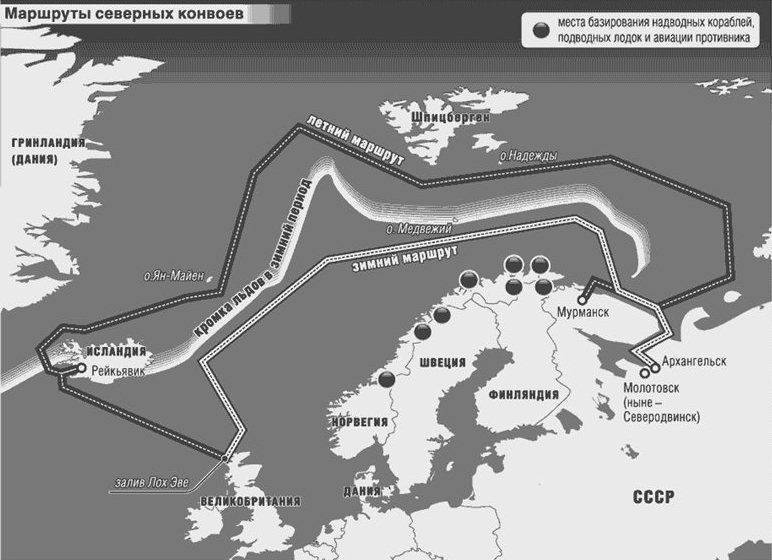
The People's Commissar of the Navy N. Kuznetsov recalled how Supreme Commander-in-Chief I. Stalin called him to the Kremlin: “You need to urgently head to the Northern Fleet. I am not sure whether everything is properly prepared there for the meeting of the Allies. ” Arriving in Arkhangelsk, the People's Commissar specified with the commander of the North fleet A. Golovko all practical issues relating to the escort of convoys and interaction with the British. The possibility of approaching the vessels not only to the Arkhangelsk berths of Bakaritsa and the Left Bank, but also to the Economy, as well as the port of Molotovsk (Severodvinsk) was discussed.
However, the British with the Americans were in no hurry to begin to fulfill their obligations. In a conversation with the Soviet plenipotentiary at the beginning of September 1941, the British Prime Minister declared that Britain would not be able to render the USSR any serious assistance - not by opening a second front, or by starting a wide supply of the necessary supplies for our army weapons.
The task of forming the convoys was assigned to the operational management of the British Admiralty. Headed this job captain 3 rank P. Edvardc (PQ Edwards). It was his initials that formed the name of the convoys heading eastward, receiving the “PQ” index, and the return convoys had the “QP” index. The first trial convoy under the symbol "РQ-0", called "Dervish", left 21 August 1941 of the year from Iceland to Arkhangelsk as part of 6 transports. The escort consisted of two destroyers and seven other warships. Before the entrance to the White Sea, he was also accompanied by covering forces: two cruisers and an aircraft carrier. On board the transports to our country were 64 aircraft, 3840 depth charges and sea mines, 10 thousand tons of rubber and other military goods. In the Barents Sea, the passenger ship Impress of Canada, accompanied by the cruiser Nigeria and three destroyers, joined the convoy. On the liner, more than two thousand workers who worked in the mines of Spitsbergen, the Soviet miners and their family members were evacuated.
On the last day of August 1941, an allied convoy “PQ-1” arrived in Arkhangelsk. It consisted of 5 transports. On October 11, the convoy PQ-2 arrived in the White Sea. Ships were unloaded in Arkhangelsk and Molotovsk. They brought tanks, fighters, guns, shells and ammunition. Each caravan was accompanied by a cruiser, 2 destroyers and 3-6 minesweepers.
The coming winter was very harsh. Heavy ice bound the White Sea and Dvina. Even icebreakers could not provide safe wiring. The Soviet government ordered the Allied convoys to be sent to the ice-free port of Murmansk. This required urgent restoration work, since after heavy bombardments the wharves and the city itself were badly damaged.
The authorized representative of the State Defense Committee I. Papanin, British representatives of the Ministry of Military Transport and the military mission arrived in Murmansk. 21 December 1941 of the year, for the first time, an Allied caravan entered the Kola Bay and stood up for unloading in Murmansk. In total, until the end of 1941, the Allied convoys arrived in the northern ports of the USSR. They all passed without loss.
According to the agreements, escorting convoys "to the north of Russia" (this expression was common among the Allies) was provided by British warships. On the meridian of Fr. Bear to the British joined the ships of the Soviet Northern Fleet.
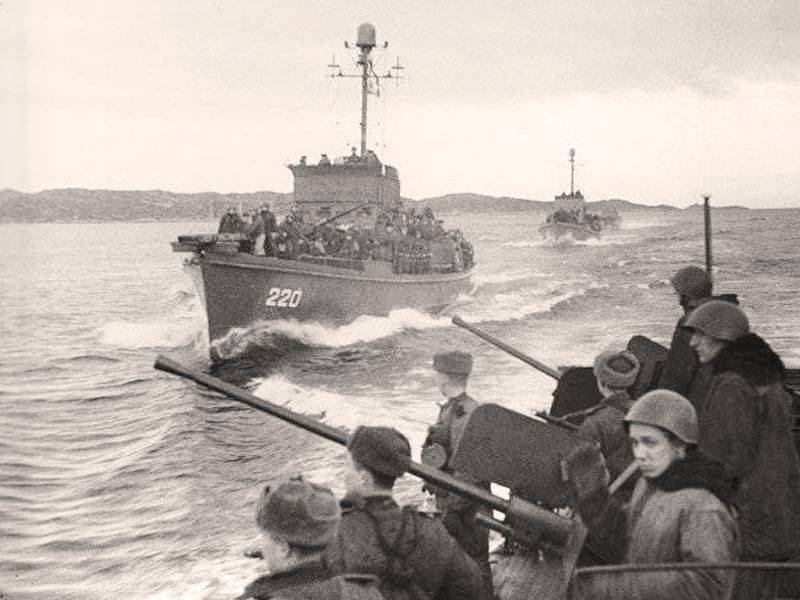
The first allied caravans totaled 5-12 ships, then their composition increased to 30-35. Lined them up in a specific order (order) on 6-8 wake columns. Above the ships of the caravan often raised small balloons barrage and air box snakes.
Armed vessels were sent to the caravans. Each vehicle usually had a pair of 4-6 inches, two or four Bofors anti-aircraft guns (40 mm) and eight to ten Oerlikon automatic guns (20 mm). Rocket launchers firing parachutes with hanging cables, depth charges and smoke screen drafts were also placed on ships. The ships were equipped with anti-mine demagnetizing windings, spies and paravanes, additional liferafts on the cables, searchlights and signal lamps. Before the military flight to the Arctic, the team received warm uniforms: jackets on fur, woolen knitted hats, boots, mittens.
In the initial period of the war, caravans were made up of ships of various types. Later, the caravans began to create a serial "empire" of English construction, "Ocean" and "Liberty" - the American, "forts" - Canadian. The most massive military transport was "Liberty" - "ships for one flight." In total, in the United States of these fairly large ships, with a displacement of the order of 10 KT, 2710 copies were built. Their main advantage was cheapness. They were built according to a simplified project and generally met the requirements of wartime.
Throughout the war, the Allies had an acute shortage of personnel for the merchant ships. A lot of random people were tempted by the high salary (500 dollars per month plus military risk premium). The forced shipbuilding program provided replenishment of the fleet, sailors did not have time to prepare. Even worse was the deal with military training. She was led on the coastal courses, but between the dangerous flights none of the sailors wanted to deprive themselves of rest and spend their free time for study. The problem was somewhat alleviated when, after the end of the course, the sailors, along with the certificates of the “royal gunner”, began to receive an award.
The British Admiralty, following the general political sentiment, was enthusiastic about forming and sending convoys to our country. The first sea lord, D. Pound, explained this point of view: “Convoys to Russia are for us a stone constantly hanging on our neck. This is the most unreliable operation in which danger lurks at every turn. ” Unfortunately, such views were not uncommon at the highest levels of British power. Naturally, such attitudes were reflected in the quantity and quality of supply.
Until the end of 1941, our Western allies did not fulfill their obligations. From the 800 aircraft promised by England, 669 was actually sent, thousands of tanks instead of 1 - just 487, tankettes instead of 600 - only 330. US for 9 months, starting in October, 1941 from 900 bombers supplied 267, from 900 fighters - 278, from 2250 tanks - 783, from 85 thousands of vehicles - 16,5 thousand. Part of the armament was outdated technology: Hurricane fighters, for example, instead of Spitfires and Aerocobr.
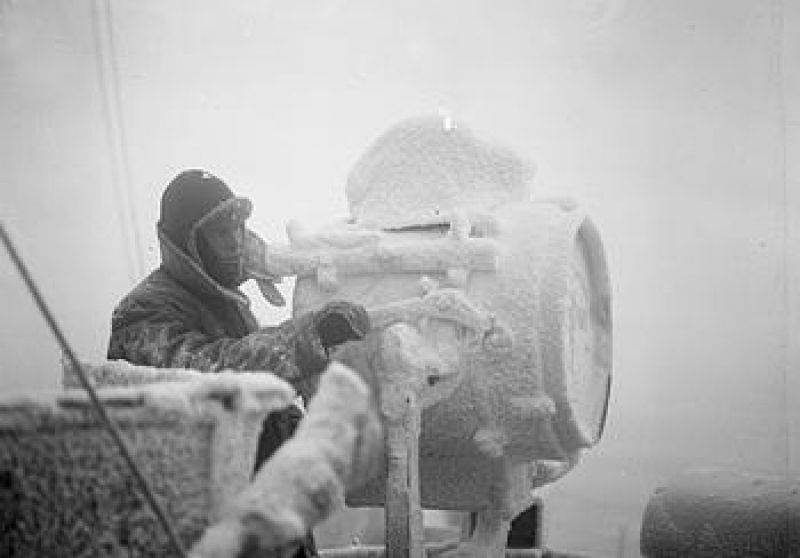
In terms of the quality of supplies, I. Stalin, in a letter to President F. Roosevelt of 8 in November 1941 of the year, was forced to note: them in broken form. "
When unloading the first convoys, it turned out that many cargoes were placed on ships in disarray, incomplete. Porters had to spend several days to find, for example, boxes with equipment for mines, radio equipment and instructions for assembling aircraft. There were no important details for acoustic trawls, depth charges.
On the eve of 1942, the Hitlerite command reviewed the situation in the Northern theater of operations. Speaking at the December 29 meeting, Hitler instructed: "All battleships should be transferred there, which, among other things, should be used to fight the Arctic convoys."
The Germans concentrated in the fjords of Northern Norway the battleship Tirpitz, the cruisers Admiral Hipper, Admiral Scheer, Lutz, Prince Eugen, Nuremberg, near 30 submarines, more than 400 aircraft. However, their actions, at first, did not bring tangible results. By the spring of 1942, of the 103 transports carried out in the Allied convoys, only one was lost.
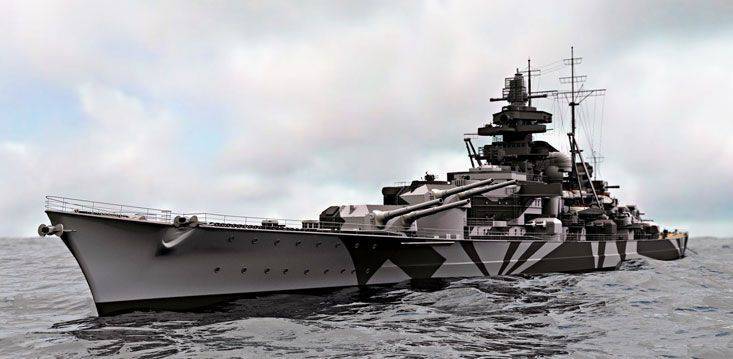
The decisive battle the Nazi command decided to give in the beginning of March 1942, the convoy "RQ-12". The most powerful German battleship Tirpitz, accompanied by three destroyers, entered the sea. The Allied Caravan was saved by stormy and foggy weather. After a three-day walk, and nowhere without finding a convoy, the squadron turned to the base. On the way back, she was suddenly attacked by torpedo bombers from an English aircraft carrier. The German battleship only miraculously escaped death.
After negotiations with the fascist fleet commander Admiral Raeder 14 in March 1942, Hitler in the wolf lair issued the first order to begin an active struggle against the convoys heading for Murmansk, which, in his opinion, up to this point had not been countered.
While preparing for a powerful blow to the convoys by the forces of the linear fleet, the Hitlerite command intensified the activity of its destroyers, submarines and aircraft. At the end of March, the PQ-13 convoy was subjected to a combined attack. From 19 transports 5 was sunk. Received damage, however, from the explosion of his own torpedo, the English cruiser Trinidad.
The Nazis regarded this raid as "significant success." 13 March 1942, Hitler reiterated that the fight against convoys going to Murmansk is currently the main task.
In April 1942, President Roosevelt reminded Churchill that there were 107 in America and England, already loaded or under load, and he would like to send them in May for their intended purpose. But Churchill, faithful to his line of procrastination, replied: "We are unable to execute your proposal." Referring to the loss of the PQ-13 convoy, he tried to delay the dispatch of convoys, at least until the end of the polar day, that is, for half a year.
In May, the British Navy suffered two heavy losses. The cruiser Edinburgh, which escorted the convoy QP-456 to Murmansk from England, was damaged by two torpedoes of the fascist U-11 submarine. The steering wheel and propeller ship screws were damaged. Escort ships tried to tow the cruiser back to Murmansk. However, the submarine managed to report on its success to the command. It immediately sent four Luftwaffe planes and four destroyers to the battlefield. The wounded cruiser desperately fired, maneuvered, hid behind a smoke screen. The flagship enemy destroyer Hermann Shoeman was sunk. But the cruiser got another torpedo. The commander of the convoy, Rear Admiral S. Bonham Carter, gave the order to leave Edinburgh. There were about 800 people on board the ship: the crew and the sailors returning to their homeland from the dead ships. The escort ships took off about 750 people, the rest died. After the evacuation of people, the English destroyer "Forsythe" finished off the cruiser. The ship went to the bottom, taking with it about 5,5 tons of gold. It was intended to pay for military supplies to the Soviet Union.
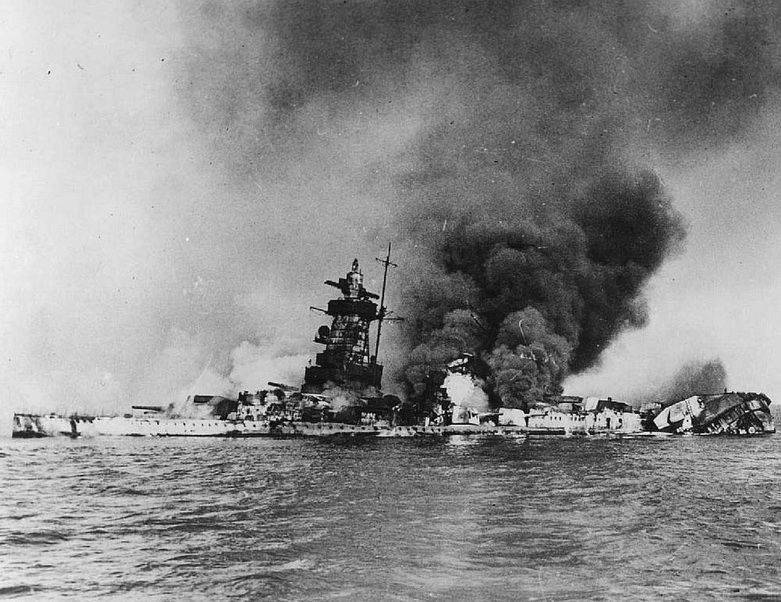
13 May from Murmansk, temporarily eliminating previously received damage, came the cruiser "Trinidad". The next day, he was attacked by fascist aviation. Bombs smashed the cruiser and it sank. The loss of two cruisers led the British Admiralty to conclude that the sending of convoys to the USSR should be stopped. Churchill was of the same opinion, but under pressure from many circumstances, he was forced to send the following memorandum to the chiefs of staff committee, which indicated the need to continue the delivery of military supplies to the USSR. The next convoy was scheduled to be sent on May 18, while Churchill pointed out: "The operation will be justified if at least half of the ships reach the destination."
20 May 1942, the next convoy "PQ-16" went east. It consisted of 35 transports - it became the largest caravan since the beginning of the war. During the transition, during the 6 day he was continuously subjected to the strongest air strikes. Fascist aviation made 245 sorties. 22 May Caravan attacked 108 bombers and torpedo bombers flying at different altitudes. In the Soviet zone, while guarding the caravan, the famous polar fighter pilot, twice Hero of the Soviet Union, B. Safonov, died. As a result of the raids, 5 transports were lost, 3 damaged. The convoy ships delivered the 321 tank, the 124 aircraft, the 2507 vehicles and thousands of tons of other military cargo.
The convoy included the American steamer Carlton. Much to the team's dismay, he began his flight from the Philadelphia 13 number on Friday. After coming to Iceland, the steamship joined the convoy, following to Russia. During one of the raids on transport dived a German plane. Literally in a few meters from the side, three or four bombs fell. Bombs disappeared under water, and then exploded. The old transport threw up "like an egg-shell", it received serious damage, lost its turn. The escort destroyers were ordered to remove people and flood vehicles. But the captain, Norwegian Hansen, refused such help and asked the trawler to take it in tow. A few days later, the wounded ship, reflecting a few more raids by fascist aviation, was towed back to Iceland. Later it went east with an escort of "PQ-17" in order not to return ... But this is in the next part.
Sources:
Suprun M. Lend-Lease and the Northern Convoys. 1941-1945 M .: St. Andrew's flag, 1996. C. 13-26, 43-57, 92-127.
Koryakin V. War in the Arctic. 1941-1945.M .: Veche, 2013. C. 32-56.
Puzyrev V., Suprun M., Bogatyrev S, Larintsev R., et al. Northern Convoys. M .: Science, 1994, S. 4-32.
Ivanov K. Konvoi to the north of Russia // Sea Fleet. 1986. No.6. C. 50-52.
Roskill S. Fleet and war. M .: Voenizdat, 1967. C. 128-132.
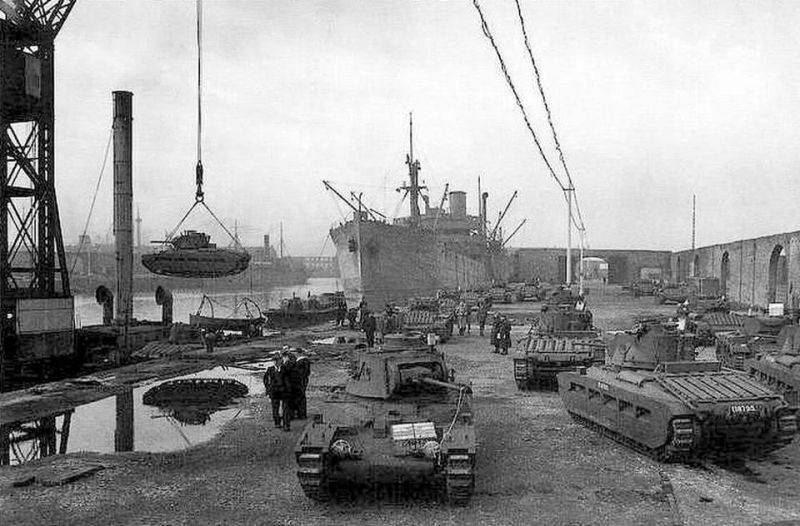
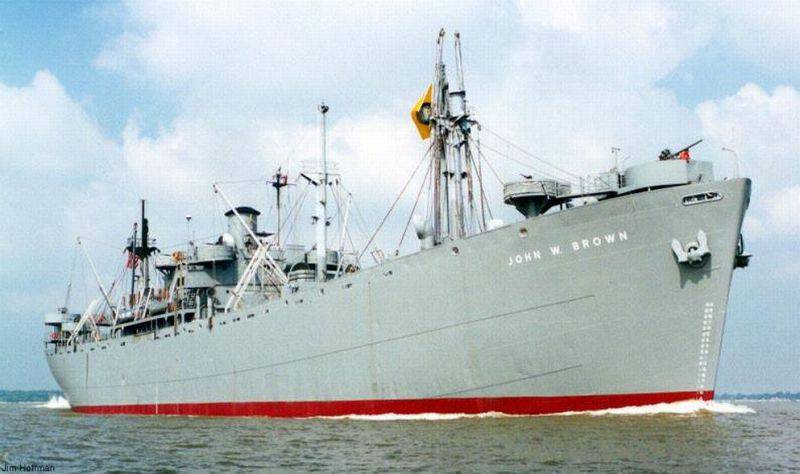
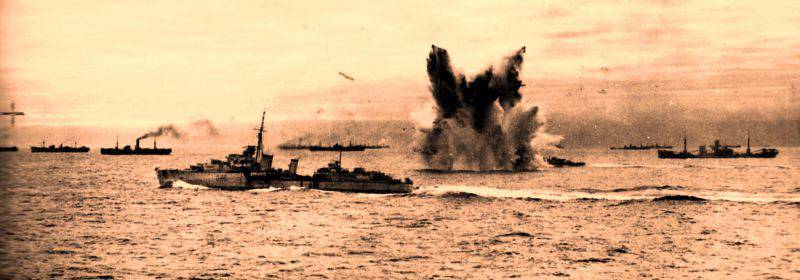
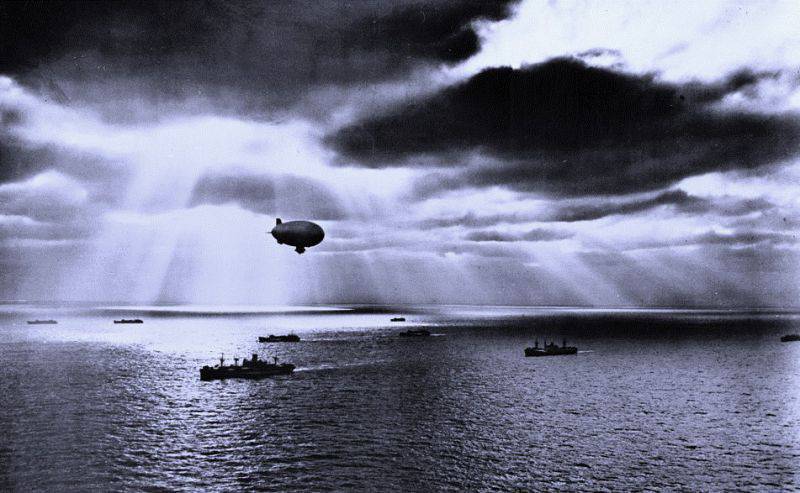
Information